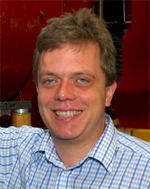|
"Our findings are a significant step in our understanding of how an atomic nucleus that is at the very edge of existence is held together." —Ingo Wiedenhoever |
FSU News FSU researchers find 'magic' at the subatomic level Do you believe in magic? Nuclear physicists at Florida State University do—and their work is helping to provide a better understanding of how all matter in the universe was, and continues to be, created.  
FSU Physics professors Ingo Wiedenhoever
(top) and Paul Cottle
Ingo Wiedenhoever, an assistant professor of physics at FSU, and graduate student Joel Fridmann have authored a paper describing an experiment they participated in as part of an international team of researchers at the Coupled Cyclotron Facility of the National Superconducting Cyclotron Laboratory at Michigan State University. Also participating in the project from FSU were Vice President for Research and physicist Kirby Kemper, physics Professor Paul Cottle, staff physicist Lagy Baby and student Eric Diffenderfer. Their work is detailed in the prestigious scientific journal Nature. "Our findings are a significant step in our understanding of how an atomic nucleus that is at the very edge of existence is held together," Wiedenhoever said. In their experiment, the FSU researchers, along with colleagues from Michigan State University, the Lawrence Berkeley National Laboratory and the University of Surrey in the United Kingdom, used a particle accelerator to fire a high-energy beam of sulfur-44 isotopes at a rigid metal called beryllium. This caused the sulfur nuclei to shed two of their positively charged protons, transforming the sulfur into isotopes known as silicon-42 (Si-42). The nuclei of Si-42 isotopes contain 14 protons and 28 neutrons—a most unusual configuration, since most atomic nuclei contain similar numbers of neutrons and protons, or more neutrons than protons. (The most common form of silicon, for example, has 14 protons and 14 neutrons in its nucleus.) If an isotope of a given element contains too few or too many neutrons, it will not be stable. Unstable atoms are radioactive: Their nuclei change or decay by spitting out radiation, in the form of particles or electromagnetic waves. In the case of Si-42, however, this proved not to be the case; the isotope was shown to be quite stable. The researchers discovered, then, that Si-42 has a "magic number" of 14 protons in its nucleus. The nuclear shell model, first proposed in 1949, states that nuclei with certain "magic" numbers of neutrons and/or protons are especially stable because the neutrons and/or protons form closed shells. The magic numbers proposed in 1949 are 2, 8, 20, 28, 50 and 82. The latest research on Si-42 provides confirmation of the first new magic number, 14, to be added to that original list. So…what does all this mean? "Nature cooked up all of the elements in the universe in massive star explosions," said Wiedenhoever. "We study these 'cauldrons in the cosmos' by re-creating their fuel and their nuclear reactions with particle accelerators. "Such research is useful in refining current theories on atomic nuclei in order to make predictions about how the elements in the universe were created," he explained. It also helps explain the physical properties governing neutron stars—stars that have collapsed under their own gravity into super-small, super-dense bodies composed mostly of neutrons. FSU researchers lead many of the scientific efforts at the National Superconducting Cyclotron Laboratory. The FSU team played a leading role in the experiment involving Si-42 described here. In addition, the laboratory's associate director for operations, Thomas Glasmacher, who also collaborated in the project described in the Nature article, earned his doctorate in nuclear physics from FSU in 1992. |
